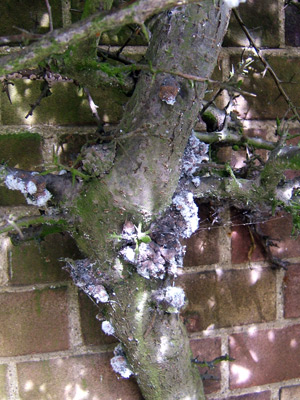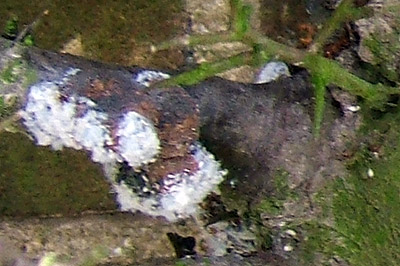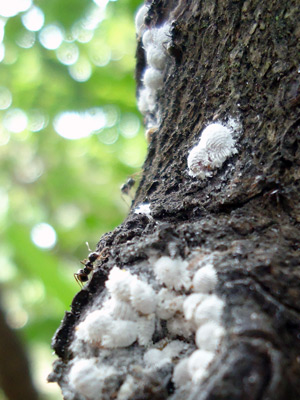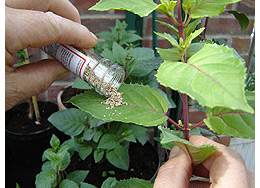Mealy Bugs - plant pest
Damage - plants are rarely killed unless very heavily infested over a long period. Commonly weakened, a heavy infestation is very unsightly from the pests themselves and from the sticky honeydew that they secrete and possibly even black moulds that grow on the sticky honeydew. Root mealy bugs damage the roots (you may have seen that one coming).
Treatment - difficult to attack from the outside, any of those organic soapy sprays just fall off from the hydrophobic (water repellent) hairs that cover the insects. Powder form insecticides sit on the hairs and again don't get the insect inside. In small numbers they can be squashed or picked off manually before they build up a larger population, otherwise it's biological control (the predators are hungry critters so you need a heavy infestation) or a systemic insecticide that is taken up by the plant and passed along in the sap right to the mealy bug.
I've never had enough to justify the biological control approach, but often get them each year on one of my Pyracathas or Japanese Maples, I keep them in control by rubbing them off or spraying insecticide on nearby leaves - very important that, the insecticide needs to get into the plant sap so that it is taken up by the insects, spraying them directly will have little effect.
There are different species which can be distinguished by the length of their tail filaments but they are all oval shaped. The most common species are the citrus mealy bug, glasshouse mealy bug and long tailed mealy bug. Nymphs and female adults cause damage. Most feed on higher parts of plants but some extract food from roots.


Mealy bugs on a Pyracantha stem, unlike other plant pests, they are often found on woody stems where they can form small colonies looking like white cotton wool.

Mealy bugs being "farmed" by ants, ants will sometimes protect mealy bug colonies in order to take advanatge of the sugary secretions they make in a similar manner to aphids
Picture used courtesy of Obsidian Soul published under CC Attribution 3.0 Unported license.
Biological control glasshouses or conservatories only
Biological control of mealy bug is with the predatory beetle,
Cryptolaemus. The adults and larvae of these beetles
eat the mealy bug completely. The larvae are similar in appearance
to the mealy bug so be careful not to remove! The beetle should
be introduced once the mealy bug are observed and a second treatment
applied later to ensure the number of predators is high enough
to compete with the mealy bug population.

Insect
hotel / house
A sheltered insect house to help a range of beneficial
insects to over-winter in your garden. If they are over-wintering there,
they are in an ideal position come the spring and summer to wake up and
help to combat any pests you may have. Amongst others, good for ladybirds,
lacewings and solitary wasps which will help keep your unwanted garden visitors
down. Place in a sheltered place outdoors.

Biological
Pest Control - Organic living pest control for a variety of
problems, red spider mite, whitefly, fungus gnats (sciarid fly), thrips, mealy bug,
vine weevils and more.
These are parasites or predators that will specifically infect the pest they are brought in to control without harming any other living things and without the use of chemicals. A small population of pests needs to be maintained so that the control agent doesn't die out.

Chemical insecticides - If your plants get a heavy infestation, then I think it's acceptable to use a chemical insecticide as a "smart missile" just on that particular plant. I resort to this when the aphids build up under cover on my favourite plum tree, or other plant/s. Don't overdo it and spray too often and don't spray the whole garden "just-in-case", buy a small 1L or thereabouts sprayer so you don't get carried away.
Not pest specific.
Copyright 2000 - present. All Rights Reserved | Privacy Policy Statement
